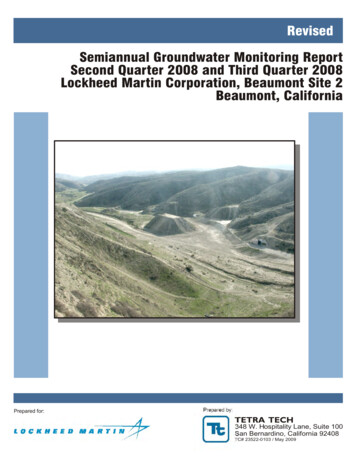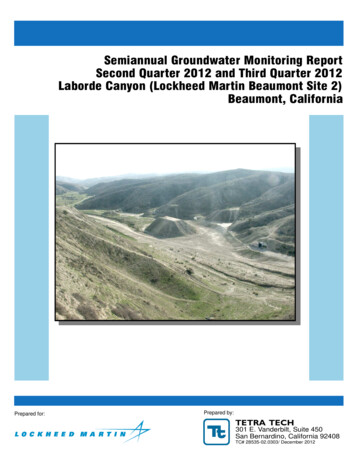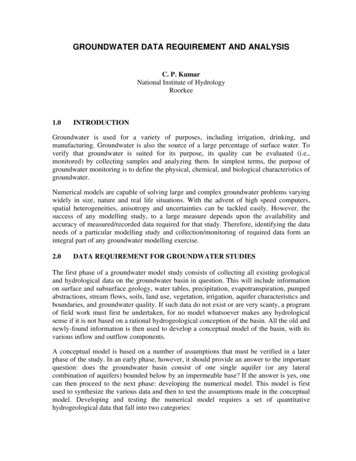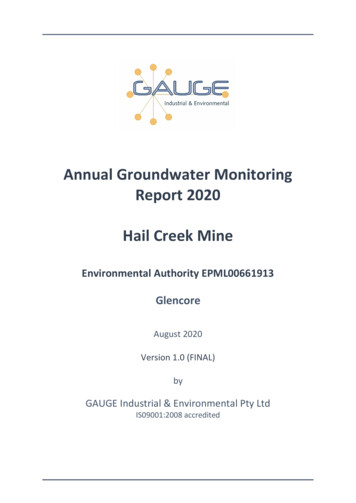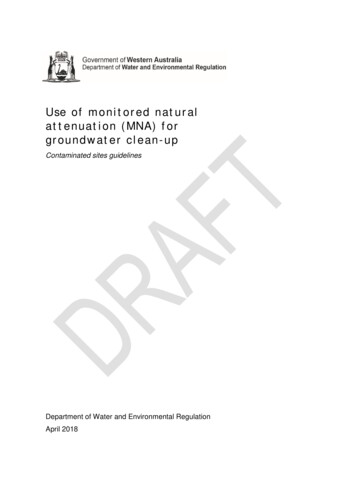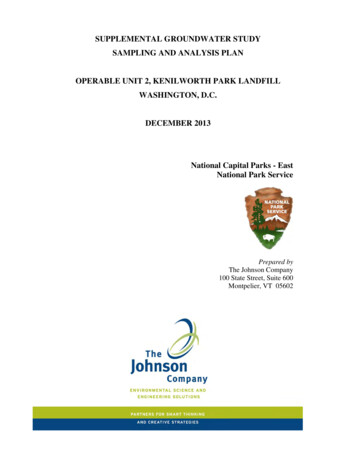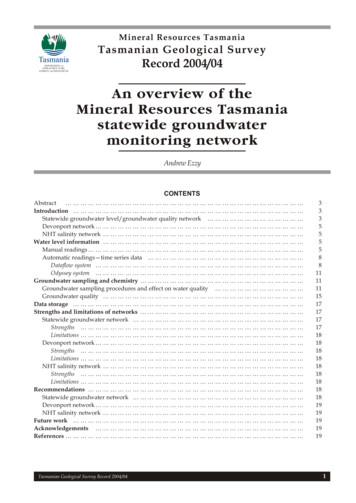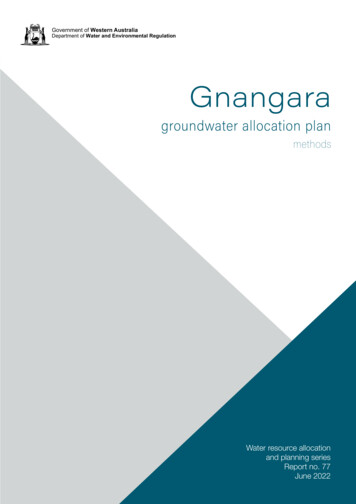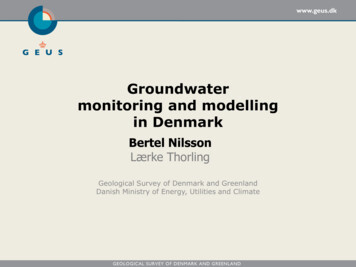
Transcription
Groundwatermonitoring and modellingin DenmarkBertel NilssonLærke ThorlingGeological Survey of Denmark and GreenlandDanish Ministry of Energy, Utilities and Climate
Take homeMESSAGESGroundwater monitoring in DKNational groundwater monitoring since 1988Waterworks wells monitoring since 1986All data are open to the public and reported everyyear. Focus on groundwater qualityGroundwater modelling in DKLong time experience with numerical modelling.National groundwater model since ca. 2000Focus on groundwater quantity
Background Groundwater constitutes 100 % of the drinking water resource in DenmarkGroundwater is heavily exploited in some areas– Drinking water to the east -Irrigation to the west (dry years only)63 % of all Denmark is cultivated agricultural areasGroundwater quality and quantity crucial for surface watersHistory– 1950:– 1988:––First national groundwater table monitoring programmeThe national groundwater monitoring programme initiated, as part of anintegrated national water monitoring programme2004: The national groundwater table monitoring programme is integrated in the overallmonitoring programme2007: The Water Framework Directive initiates a change in monitoring strategy andredesign of the monitoring network
What is Groundwater monitoring?Groundwater monitoring collects data of relevance forpolicy and management issues in the water sector. Specialfocus on establishment of time series, mapping secondaryGroundwater quantityGroundwater qualityGroundwater table soundingsWater abstractionsGroundwater samples from Monitoring wells Abstraction wells at allwater works wells in DKPoint source data are handledseparately (in DK)National hydrological modelNo data from private drinkingwater wells or drinkingwaterused to asses status or trend.
GroundwaterMonitoring EU directives European Env. Agency Municipalities and EPA Waterplans other planning Efficiency of measures Inspection of water mination Methodology Interpretation Dating Water cycle Analytical methods Modeling Yearly reports Thematic reports Intercalibration Lectures and talks Articles Cooperation EPA, EU etc.
Monitoring of groundwater in esLeaching (PLAP)Point ingwellsDrainSuction cupsMonitoringwells(permanentand temporal)AbstractionwellsWhyDrinkingwaterNOVANA Water PlansLicense forpesticidesOld /AU/EPAenvironmentRegionsHow many 6.000700-800/year( 1500)5 areas 15.000 plots? Pesticides ?ReportingGEUSGEUSGEUS/AURegions/Consultants
Flow of Groundwater MonitoringDataEnvironmental Agency/Water WorksSampling & field measurements (Standards)LaboratoriumChemical analysis (ISO- standards)LaboratoriumData, upload to databases JUPITER, (code system)GEUSInterpretation (Reporting data to EEA)GEUSKnowledgeEnvironmental AgencyPolitical evaluationMinister/ParliamentPolitical reaction/legislationEU Commission EEAPolitical reaction/legislationMunicipalities etc.Implementation in administration
GEUS and Groundwatermonitoring in DK The national groundwater monitoringprogramme is conducted by EPA and GEUS incooperation. EPA sets the political and economicalframework GEUS sets the Technical and scientificframework, through manuals and technicalguidelines (expertise and datacentre) EPA is responsible for collection of samples,contact to laboratories and primary datamanagement GEUS is responsible for the yearly reporting ofdata to the political system and the public. GEUS host the database JUPITER, with allrelevant groundwater data
Monitoring strategyNeed to have representative data:GeographicGeologicalgeochemicalLand use and groundwater in risk.Relevant choice of parametersRelevant frequencyDesign of monitoring wells1988-2006:Principle:Know the details in 72 areasand generalise to national levelUnderstand the local dynamicsUse it globalAll monitoring points sameparameters and frequency2007:Principle:WFD demands monitoring fitting theapprox. 400 groundwater bodiesMore distributed monitoringnetwork under establishmentParameters and frequencyaccording to riskDifficult to stick to just one monitoring strategy in achanging political environment over almost 30 years.
Present DesignDanish Groundwater Monitoring sites Monitoring in 65 clustered areas of 5-50 km2each with 20-25 wells and 1 m screen.(700 samples/year) Additional monitoring in groundwater bodiesat risk (140 samples/year) Multilevel monitoring in 5 deep groundwaterwell (4x80 samples every 3. year) Detailed monitoring of surface neargroundwater in 5 small agriculturalcatchments (6x100 samples/year) A total of 1600-2000 monitoring points One water sample: up to 97 parameters:26 main elements, 14 heavy metals, 23organic micro-pollutants, and 34 pesticides
Methodologies and toolsField work/ Practical work Water sampling and drilling new wells Traditional hydrogeological field work Database development and handling of dataIncorporation of state of art scientific work 5D conceptual framework for data interpretation All authors in reporting have their theme as scientific working field Monitoring groundwater effect on surfacewater/dependent ecosystems Cooperation at a EU level (CIS for WFD) Cooperation with EEA Technical guidance Field work, sampling, sounding etc. Data management, database work
Depths of monitoring wellsDepth of new sampling points m b.s.
Data available for interpretationNumber of monitoring pointsNumber of pesticide sampesNumber of nitrate samplesNumber of arsenic samples
The annual report Theme authors with expertise inrelevant subject Same paradigm for every 6 yearprogram period Target groups : Danish parliament,EPA, Waterworks, NGO etc. Reporting is coordinated with otherenvironmental monitoringprogrammes Only electronic reporting Only national reporting, no regional Published every year since 1989 Next issue 3. Dec. 2015 on 2014 dataThorling et al, 2015, report
Main topics of the Report The monitoring network, goals, legal framework and adjustments Groundwater Age, Hydrogeology : relevant Background Knowledge Nitrate Phosphorous Redox-wells Organic Micro pollutants Trace elements Pesticides Water abstraction Groundwater table NOVANA-model
5D understanding of groundwater quality:Prerequisite for monitoring strategy and interpretationof Chemical state, Trend and DynamicsEvery sample represents a 5D point: (x,y,z,tr,ts).(x,y,z) the location of the filter,tr the time of groundwater recharge, (period)ts the time of sampling.This statement can easily be said,The huge implications are to often ignored
Dating of groundwaterCFC and 3H/3He datingSF6 tested not useful14C not relevantNot all monitoring points can be dated due to practical issuesThorling et al, 2015, report
Conceptual modelsgeochemistry – and hydro-geologyWestEast/SouthEast/NorthAcidification clineclayGroundwater tableGroundwater tableRedox clineclaylimestoneRedox clineSource: Jørgensen & Stockmarr 2009Acidification clineNo clear acidification- nor redox- cline
Conceptual models are the Basic of all monitoring strategyHow to understand the vulnerability of groundwatertowards nitrate and pesticides
What is the state and trendsin the nitrate content for groundwater?Simple question, many possible answers.Indicators: Standard figuresMonitoring data.
What is the Status and trends of the nitratecontent in groundwater used for drinking water ?Simple question, clearer answerbut No consideration to abstracted amounts only pr. well.
Is there karstin Denmark ? karst phenomena Bertel Nilsson(bn@geus.dk)
Groundwater monitoring in DK National groundwater monitoring since 1988 Waterworks wells monitoring since 1986 All data are open to the public and reported every year. Focus on groundwater quality Groundwater modelling in DK Long time experience with numerical modelling. National groundwater model since ca. 2000 Focus on groundwater quantity
